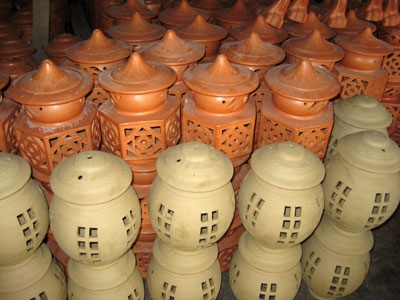Located next to the ancient quarter of Hoi An, the Thanh Ha ceramic village has been in existence for a long time. The village is famous for its traditional ceramic products.
In the 1990s, the village was a different kind of place and plastic and aluminum products were the rule. During those years, ceramic making was not happening in the village. In recent years, the tourism in Hoi An has taken off, and some families in Thanh Ha village dug back into their history and brought traditional ceramics back to life. Besides making ceramic ware for the everyday needs of the common people, the villagers are also turning out souvenirs to sell to the tourists. They are doing well with children`s toys, lampshades, and indoor decorative items.
By the end of 2004, the craft was pretty much in full swing in Thanh Ha. The village began receiving orders from the new big hotels in Hoi An. However, to get a firm market position for the ceramic products, the local administration still has a few things to do.
In early 2005, the Industry Department of Quang Nam province carried out a pilot project to build a new-technology kiln that promises to consume less fuel and produce higher quality ceramics. The kiln is there but it sits idle because no one knows how to use it.
In the tourism development plan of Hoi An, Thanh Ha is mentioned as one of the places that needs investment in ecological tourism. Just because of its location next to the Hoi An ancient quarter, Thanh Ha has a better chance than some other traditional villages in Quang Nam province such as the Tra Que vegetable village, the Kim Bong carpentry village, and the Phuoc Kieu bronze casting village. However, visitors to Thanh Ha may be a bit disappointed when seeing the narrow range and unimaginative design of its ceramic products.
A member of Hoi An`s leadership, Nguyen Su, says, "We plan to invest in developing a number of craft villages surrounding Hoi An, including Thanh Ha. That is a very costly proposition. A happy fact is that the simple ceramics made by the Thanh Ha villagers are being bought by the tourists because of their honest and simple designs."
Nevertheless, it's true that Thanh Ha village`s ceramic products are made in the old way and cannot compete with the mass-producers in terms of commercial appeal, mass sales and uniformity. Their inability to obtain a proportionately higher price has a direct influence on the lives of the people.
"Each ceramic kiln in Thanh Ha village can hold two large boats of clay. And it takes more than 20 days to make finished ceramic products for which we can get just VND3-4 million. A gas-fired kiln of the same capacity in Bat Trang village can make products for which they can get tens of millions of dong or even VND100 million in just one week," Mr. Tuan says. One cannot compete commercially when making ceramics by old methods.
Hopefully, Quang Nam province, Hoi An and Thanh Ha will find a way to market the peculiar and valued ceramics of Thanh Ha village so that the potters can thrive and the craft can continue.






































































































